For the opportunity Tokina AT-X 116 PRO lens review SD 11-16mm F2.8 (IF) DX II Aspherical Many thanks to Nikon for Artyom Salekh who sent me a lens for viewing from another area.
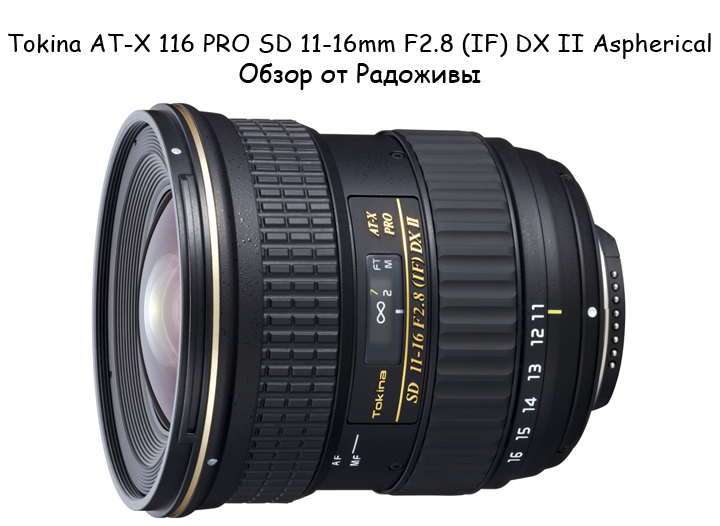
Review of Tokina AT-X 116 PRO SD 11-16mm F2.8 (IF) DX II Aspherical
Tokina AT-X PRO Lens SD 11-16mm F2.8 (IF) Dx ii and his younger brother Tokina AT-X PRO SD 11-16mm F2.8 (IF) DX Are unique wide-angle APS-C cameras. Why unique? Because neither Nikon nor Canon has such an ultra-wide angle for APS-C cameras with such aperture.
Main technical characteristics of Tokina AT-X 116 PRO SD 11-16mm F2.8 (IF) DX II Aspherical N / AIS:
| The name of the instance from the review (as it is written on the lens itself) | Tokina AT-X 116 PRO SD 11-16mm F2.8 (IF) DX II Aspherical N/AIS |
| Basic properties |
|
| Front Filter Diameter | 77 mm |
| Focal length | 11-16 mm EGF for Nikon DX cameras is 16.5-24 mm |
| Zoom ratio | 1.45 x |
| Designed by | for Nikon APS-C digital cameras |
| Number of aperture blades | 9 rounded petals |
| Tags | window with focusing distance in meters and feet, focal lengths for 11, 12, 13, 14, 15, 16 mm, bayonet mount mark. Hood Attachment Mark |
| Diaphragm | from f / 2.8 over the entire range of focal lengths to f / 22 |
| MDF (minimum focusing distance) | 0.3 m, the maximum magnification ratio is reached by 16 mm and is 1: 11.6 |
| The weight | 550 g |
| Optical design | 13 elements in 11 groups. The scheme includes 2 low dispersion elements (shown in blue on the optical diagram), as well as 2 aspherical element (shown in pink in the optical diagram). The presence of such elements is indicated on the body by the abbreviations 'SD' (Super Low Dispersion) and Aspherical.
The image of the optical circuit is clickable. Optical design similar to lens Tokina 116 AT-X PRO SD 11-16mm F2.8 DX (first version, for Nikon cameras without inboard motor focusing). Also, the same optical scheme is used in the lens Tokina Cinema 11-16mm T3.0. |
| Lens hood | BH-77B |
| Manufacturer country | JAPAN |
| Period | Issued since September 2008. Original non-motorized version Tokina 116 AT-X PRO SD 11-16mm F2.8 DX was introduced in 2007. Subsequently, a replacement / addition in the face Tokina AT-X PRO SD 11-20mm F2.8 (IF) DX. |
| Price |
Tokina AT-X PRO SD The 11-16mm F2.8 (IF) DX II is a wide-angle (ultra-wide-angle) zoom lens that is perfect for anyone who likes to put more space in the frame. The Tokina AT-X 116 DX II is very well made, it immediately feels pleasant in your hands japanese lens... The Tokina AT-X 116 DX II weighs about 560 grams. The optical design consists of 13 elements in 11 groups, 2 elements are aspherical and 2 elements are made of low dispersion glass (Super-low Dispersion - letters SD in the lens name). The Tokina AT-X 116 DX II lens for Nikon cameras is automatically AF-S, G and DX compatible.
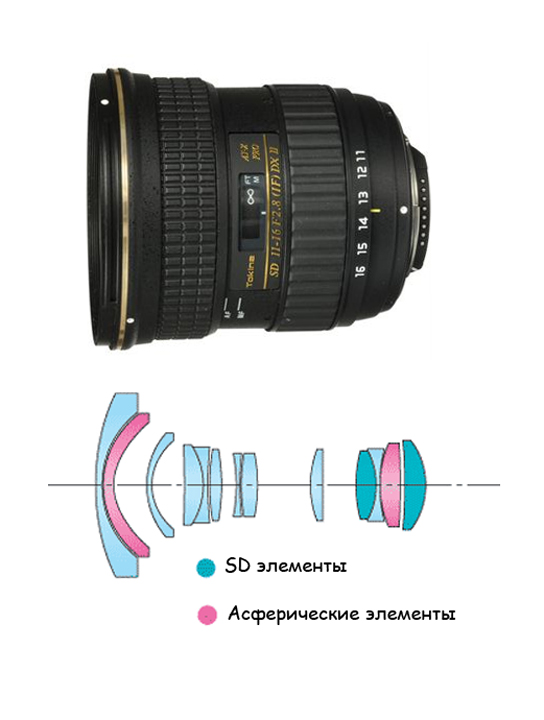
Optical design of the Tokina AT-X 116 PRO SD 11-16mm F2.8 (IF) DX II lens
The lens has built-in focus motortherefore Tokina AT-X 116 DX II will automatically focus with all Nikon central locking cameras. When focusing the motor is pretty noisybut auto focus on the lens fast enough. When focusing, the front lens does not move, as the lens has internal focusing system (denoted by 'IF' in the name). Tokina AT-X 116 DX II has very convenient focus mode switch ring (called One-touch Focus Clutch Mechanism - one-touch focus switching mechanism).
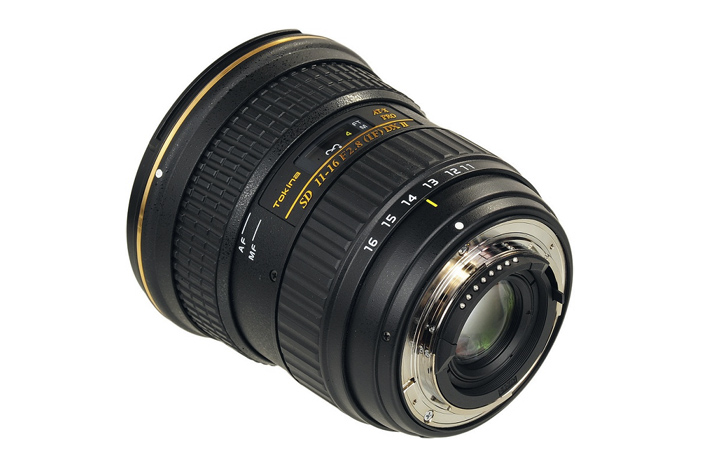
Tokina 11-16mm DX II - Back View
To set the manual focus method to 'MF', simply pull the focusing ring towards you. To enable automatic focusing 'AF', simply pull the focusing ring away from you. In manual focus mode, the focus ring rotates 90 degrees. The focusing ring is rubberized, and manual focusing on a wide-angle lens is a snap. In focus mode 'AF', the focus ring rotates freely and does not affect the focus itself. The lens has a focusing distance scale in meters and feet. On the focusing scale, infinity 'starts' at just 1.2m. The minimum focusing distance is 30 centimeters, you can forget about macro on a wide-angle lens. The Tokina AT-X 116 DX I gives an approximate maximum magnification of only 1:12. I wanted the lens to have an even smaller MDF.
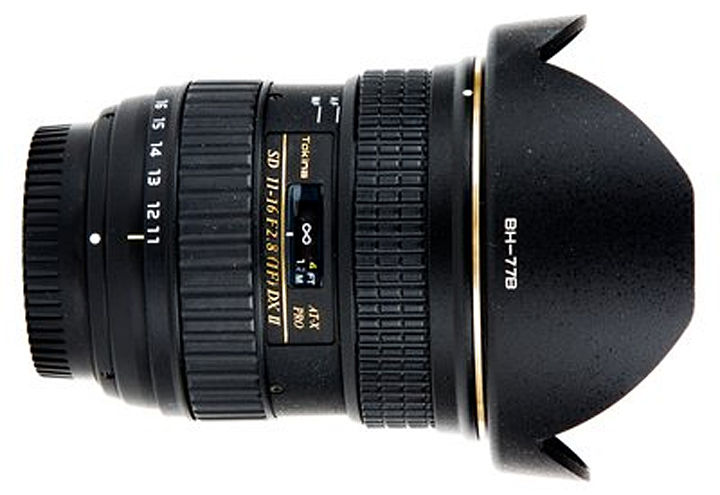
It looks like a lens with a lens hood
When zooming, the front lens does not remain motionless, and performs light translational movements back and forth. Roughly speaking, when the filter is dressed and / or with a hood on, the lens does not change its physical size. The zoom ring is also rubberized.
Aperture has 9 rounded petals. It was very difficult for me to achieve star ray effect with this lens.
But the lens does not have a depth-of-field scale. When focusing, the lens often freezes in the extreme position, you need to press the focusing button several times for the lens to 'come to life'. The lens uses a 'professional' diameter at 77mm for the front light filter.
Difference between DX and DX II lens versions
- DX II has a built-in focus motor
- DX II has improved enlightenment, DX II is already on with such an icon
- DX II has a different coloring of indicators on the lens
- According to the description, the DX II has a slightly improved production quality, but I do not really believe in it
- The weight of the lens differs by a few grams
- DX II has more microprocessor pins
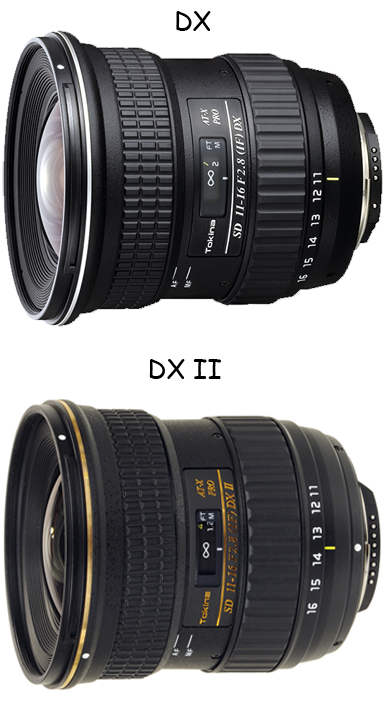
So different versions of DX and DX II
For Canon, in the new version of DX II, only the enlightenment and the color of the letters on the lens have been changed. When used on Nikon DX cameras EGF lens will be 16,5-24mm, and for Canon APS-C EGF will be 17,6-25,6mm.
Canon Camera Ownersthat came to me to Radozhiv, where the second version of the Tokina AT-X 116 PRO SD 11-16mm F2.8 is described for Nikon cameras, it will be interesting to read the review and test of the Tokina AT-X 116 PRO SD 11-16mm F2.8 of the first version for Canon Systems Online vlador.com.
The lens comes with a BH-77B lens hood. The hood can be worn back-to-front, while losing access to the focus ring.
Sample Photos
All photos taken using protective filter Marumi DHG Super UV 77mm Made in Japan, photo without processing. The lens has a very well corrected distortion of 16 mm and a slightly noticeable distortion of 11 mm. For such an extreme wide angle distortion indicators are very good. Vignetting on Nikon DX cameras is no problem. The lens normally tolerates back and side light, but can catch hares. Lens very sharp, in the corners the sharpness is a little worse. In general, image quality on high.
Additional interesting and useful information (though everything is in English):
- Ken rocwell responds well to this lens
- Information on the official website
- Charts, MTF tables, but only for the first model on Photozone.de
- Video - boring lens comparison with Nikon's flagship 14-24mm full frame
- Kai wong can always have fun
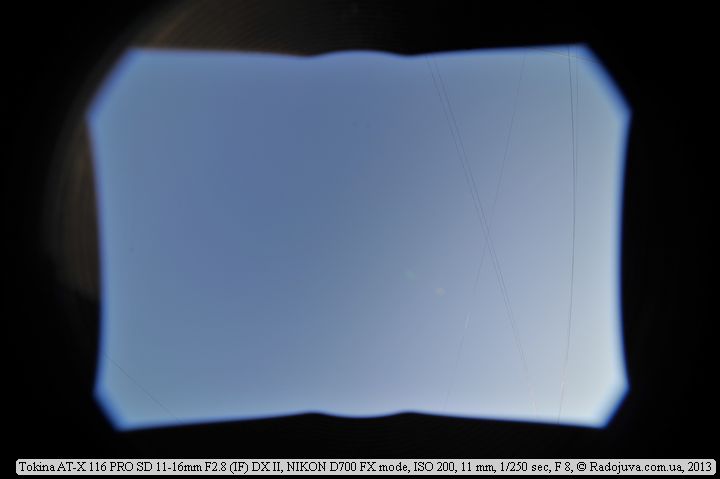
Full-screen camera example with a hood and filter
Lens may work well on full-frame camerasif used only at 16mm focal length. I used Tokina AT-X 116 DX II on a full-format camera Nikon D700, wherein:
- In the range 11-15, a strong darkening of the edges of the image is visible, as shown in the photo above.
- At 16mm and a minimum focusing distance, vignetting is noticeable and intensifies when the aperture is closed
- At 16mm and focusing on infinity, there is weak vignetting at F / 2.8, when the aperture is closed, the vignetting disappears completely
I was very pleased with the opportunity to shoot with this lens in full frame. True vignetting is enhanced by the use of filters and a hood.

An example on a full-format camera. Left and right are strong sources of backlight. Visible glare bunnies.
Personal impressions
The Tokina AT-X 116 PRO SD 11-16mm F2.8 (IF) DX II is a great lens. Native alternatives for Nikon DX cameras can be Nikon 12-24mm f / 4 DX AF-S и Nikon 10-24 / 3.5-4.5 DX AF-S... In search of a good 'shirik', I advise you to look away Tokina AT-X 124 PRO DX II 12-24mm f4 и Tokina AT-X 128 PRO DX 12-28mm f4.
Real prices for the Tokina AT-X 116 DX / DXII lens can see here, or in the price block below:
All Tokina 11-16 prices
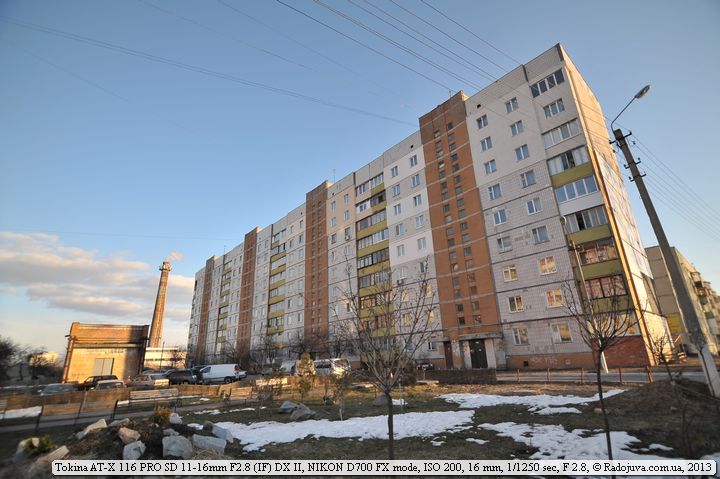
Sample photo on an FX camera. Corners are corrected in the editor.
Using Tokina AT-X 116 DX II is very easy take off, since the wide-angle lens does not require fast shutter speeds. You can even at night take off at 11mm focal length and f / 2.8 aperture. Working with such a wide-angle lens opens up a huge field of creativity - from playing with perspective for small objects to super landscapes.
The lens has everything 1,45x zoomWhen photographing with the Tokina AT-X 116 DX II, you hardly feel the ability to zoom. This is probably the lens with the smallest zoom ratio and this is one of the disadvantages of the Tokina AT-X 116 DX II. With such a lens, you always want to shoot at 11 mm, and sometimes this is not enough, so I do not recommend worrying about the low zoom ratio. A similar zoom ratio is available for the darker analog - Tamron Aspherical LD DI II SP AF 11-18mm 1: 4.5-5.6 [IF] A13... Also, the Tokina AT-X 116 DX II does not have constant manual focus control, such as on Nikon lenses, which have a focus mode 'M / A' (not to be confused with 'M' - 'A').
Alternatives
Below is a list of all ultra-wide angle lenses with auto focus support for cameras with an APS-C sensor (crop Kf = 1.5-1.6X) whose focal length is less than or equal to 14 mm.
Tokina (for different mounts):
With moderate aperture:
- Tokina 124 AT-X PRO SD 12-24 mm F4 (IF) DX Aspherical, for Nikon F, Canon EFS
- promaster Digital af 12-24 XR EDO F4 Aspherical, previous lens under the 'ProMaster' brand
- Tokina 124 AT-X PRO SD 12-24 mm F4(IF)DX II aspherical, for Nikon F, Canon EFS
- Tokina 128 AT-X Pro SD 12-28 mm F4 (IF) DX Aspherical, for Nikon F, Canon EFS
- Tokina AT-X PRO SD 12-28 F4 (IF) DX V, Canon EFS only
Aperture:
- Tokina AT-X PRO SD 11-16 F2.8 (IF) DX ASPHERICAL, since 2007, for Nikon F, Canon EFS, Sony A
- Tokina AT-X PRO SD 11-16 F2.8(IF)DX II ASPHERICAL, since 2008, for Nikon F, Canon EFS, Sony A
- Tokina AT-X PRO SD 11-16 F2.8 (IF) DX V, for Nikon F, Canon EFS
- Tokina atx-i 11-16mm F2.8CF, since 2019, for Nikon F, Canon EFS, black/white
- Tokina atx-m 11-18mm F2.8E, since 2022, for Sony E, black/white
- Tokina AT-X PRO SD 11-20 F2.8 (IF) DX ASPHERICAL, from 2014, for Nikon F, Canon EFS
- Tokina atx-i 11-20mm F2.8CF, since 2020, for Nikon F, Canon EFS, black/white
- Tokina AT-X PRO SD 14-20mm F2 (IF) DX, from 2015, for Nikon F, Canon EFS
fisheye:
- Tokina 107 Fisheye 10-17 mm F3.5-4.5DX AT-X, for Nikon F, Canon EFS
- Tokina 107 Fisheye 10-17 mm F3.5-4.5 DX NH AT-X, for Nikon F, Canon EFS
- Tokina 107 Fisheye 10-17 F3.5-4.5 DX AT-X V NH, Canon EFS only
Tamron (for different mounts):
- Tamron SP 10-24 mm 1: 3.5-4.5 Di II B001, from October 2008, for Nikon F, Canon EFS, Pentax K, Sony A. Japan / China / Vietnam
- Tamron 10-24 mm F/3.5-4.5 Diii VC HLD-B023, from February 2017, for Nikon F and Canon EFS
- Tamron Aspherical LD DI II SP AF 11-18 mm 1: 4.5-5.6 [IF] A13, since 2005, for Nikon F, Canon EFS, Sony A. Konica Minolta AF DT Zoom 11-18mm 1: 4.5 (22) -5.6 D and Sony 4.5-5.6 / 11-18 DT (SAL1118) lenses are built on the same optical scheme )
- Promaster Digital EDO AF Aspherical LD (IF) 11-18 mm 1: 4.5-5.6, previous lens under the 'ProMaster' brand
- Tamron 11-20 mm F / 2.8 Di III-A RXD B060, from April 2021, only for Sony E
Sigma (for different mounts):
- Sigma 4.5 mm 1: 2.8 EX DC HSM CIRCULAR FISHEYE, since 2007 for Canon EFS, Sigma SA and Nikon F. Since 2008 for Pentax K and Sony / Minolta A
- Sigma 10 mm 1: 2.8 DC FISHEYE HSM, from 2007 for Canon EFS, Sigma SA and Nikon F. In 2008 a version for Pentax K and Sony / Minolta A was released
- Sigma 8-16 mm 1:4.5-5.6 DC HSM, since 2010, Canon EFS, Nikon F, Pentax K, Sigma SA, Sony/Minolta A
- Sigma 10-20 mm 1: 4-5.6 DC EX [+ -HSM, + -D], since 2005 for Canon EFS, Sigma SA, Nikon F, Pentax K and Sony / Minolta A. Since 2008 for 4/3 SLR system. 'D' prefix for select Nikon and Sony / Minolta A only. HSM motor only available for Canon EFS, Sigma SA, Nikon F and 4/3. The Pentax K and Sony / Minolta A versions have a different appearance (there is no focusing distance window). There are two sub-versions: with a matte finish and with a velvet finish on the body.
- Sigma 10-20 mm 1: 3.5 DC HSM EX, since 2009, for Canon EFS, Nikon F, Pentax K, Sigma SA, Sony / Minolta A
- SIGMA 10-18 mm 1:2.8 DC DN C, from 2023, for Sony E, FujiFilm X and Leica L
Nikon DX (for Nikon F mount):
- Nikon DX AF Fisheye Nikkor 10.5 mm 1: 2.8G ED
- Nikon DX VR AF-P Nikkor 10-20 mm 1: 4.5-5.6G
- Nikon DX AF-S Nikkor 10-24 mm 1: 3.5-4.5G ED SWM IF Aspherical
- Nikon DX AF-S Nikkor 12-24 mm 1: 4G ED SWM IF Aspherical
- Nikon Nikkor ZDX 12-28mm 1:3.5-5.6PZ VR
Canon EF-S / EF-M
EF-S (Mirror APS-C)
EF-M (Mirrorless APS-C)
RF-S (mirrorless APS-C)
Pentax DA (+ Samsung / Schneider-Kreuznach, for Pentax K mount):
- SMC Pentax-DA 1: 2.8 (22) 14 mm ED [IF] (Pentax 14)
- SMC Pentax-DA FISH-EYE 1: 3.5-4.5 10-17 mm ED [IF] (Pentax 10-17) (FISHEYE, most likely optically identical Tokina Model 107)
- HD Pentax-DA FISH-EYE 1: 3.5-4.5 10-17 mm (FISHEYE, most likely optically similar to Tokina 107 NH)
- HD PENTAX-DA * 1: 2.8 11-18 mm ED DC AW
- SMC Pentax-DA 1: 4 12-24 mm ED AL [IF] (Pentax 12-24) (most likely optically identical Tokina Model 124)
- Samsung Zoom Lens Fisheye D-Xenon 10-17 mm 1: 3.5-4.5 AL, copy Pentax 10-17optical scheme from Tokina Model 107
- Samsung Zoom Lens D-Xenon 1: 4 12-24 mm ED ALcopy Pentax 12-24optical scheme from Tokina Model 124
- Schneider-Kreuznach D-Xenogon 1: 3.5-4.5 10-17 mm ED AL, copy Pentax 10-17optical scheme from Tokina Model 107
- Schneider-Kreuznach D-Xenon 1: 4 12-24 mm ED AL, copy Pentax 12-24optical scheme from Tokina Model 124
Sony / Minolta (A or E):
E-mount (E):
- Sony E 4 /10-18 OSS (2012)
- Sony E 4 /10-20G PZ (2022)
- Sony E 1.8 /11 (2022)
A-mount (A):
- Sony 4.5-5.6 /11-18 DT (SAL1118) (most likely optically identical Tamron model a13)
- Konica Minolta AF DT Zoom 11-18 mm 1: 4.5 (22) -5.6 D (most likely optically identical Tamron model a13)
Samsung NX
- Samsung Lens 1: 3.5 10 mm Fisheye
- Samsung Lens 1: 4-5.6 12-24 mm ED I-FUNCTION
Fujifilm x
- FUJINON ASPHERICAL LENS SUPER EBC XF 8 mm 1:3.5RWR
- FUJINON ASPHERICAL LENS SUPER EBC XF 14 mm 1: 2.8 R
- FUJINON ASPHERICAL LENS NANO-GI XF 8-16 mm 1: 2.8 R LM WR
- FUJINON ASPHERICAL LENS SUPER EBC XF 10-24 mm 1: 4 R OIS
- FUJINON ASPHERICAL LENS SUPER EBC XF 10-24 mm 1: 4 R OIS WR
Zeiss (E / X)
- ZEISS Distagon Touit 2.8 /12 T* (Sony E-mount, Fujifilm X-mount)
VILTROX (E/X/Z)
- Viltrox AF 13mm 1: 1.4 STM ASPH ED IF C (2021, Sony E-mount, Fujifilm X-mount, Nikon Z-mount)
Leica CL/TL/T/L
- Leica SUPER-VARIO-ELMAR-T 1: 3.5-4.5 /11-23 ASPH. (2014)
- Leica SUPER-VARIO-ELMAR-TL 1: 3.5-4.5 /11-23 ASPH. (2014)
Samyang (E / X)
- Samyang AF 12/2E + Samyang AF 12/2X (2021, Sony E-mount, Fujifilm X-mount)
Yongnuo (E/X/Z)
Yongnuo 11mm 1:1.8 DA DSM WL S/X/Z (2023, Sony E-mount, Fujifilm X-mount, Nikon Z-mount)
Do you know more similar lenses? Or do you have experience with any of them? Then be sure to share your thoughts in the comments.
Comments on this post do not require registration. Anyone can leave a comment. Many different photographic equipment can be found on AliExpress.
Conclusions:
If you need good wide-angle aperture zoom for Nikon DX cameras - for these purposes Tokina AT-X 116 DX II fits like no other.
December 24, 2014 lens Tokina AT-X PRO SD 11-16 F2.8 (IF) DX II ASPHERICAL has been updated to version Tokina AT-X PRO SD 11-20 F2.8 (IF) DX ASPHERICAL.
Material prepared Arkady Shapoval. Training/Consultations | Youtube | Facebook | Instagram | Twitter | Telegram

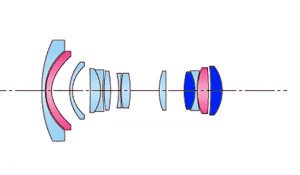
















Good day. I can’t understand why the focal length for the crop (Nikon) will not be 11-16? Marking on the DX lens, a photo from the camera’s FF shows cropped angles, the lens is positioned everywhere for crop. But in the end, the focal point is not what is indicated on the lens. Help with practical advice
Just do not confuse FR and EGF. FR on any camera will be 11-16.
Because the focal one is one. .on the crop, it is simply already the angle, and the FR is recalculated to the EGF, but on the object they still write the FR
It turns out that the division of lenses into two camps: for crop and for ff cameras is just a marketing ploy?
no. They all have the same focal point.
But if you put on the lens from the crop on the FF, you will get the strongest vignetting.
crop lenses are smaller, lighter, and cheaper than FF lenses.
An example is 55-300 and 70-300 for Nikon.
Summing up (for myself): if I need 11mm for a crop, then this lens is what I need. And EGF is all from the evil one and you shouldn't bother yourself with this, but just enjoy the photo process :)
if you need 11 mm for a crop - then yes, if you need an IMAGE ANGLE equal to the angle that gives 11 mm of focal length on a full frame - then you will have to look for something of the order of 8 mm.
...
and 11 mm of the focal length on the crop will give an angle of the same width as 16 mm on the FF.
I have a nikon 12-24 / 4, but no one writes about him, and he has a more reliable mechanism than Tokinovsky and no chrome. aberrations, and the sharpness is unique throughout the frame. My opinion is Nikon 12-24 is better.
I have a nikon 12-24 / 4, but no one writes about him, and he has a more reliable mechanism than Tokinovsky and no chrome. aberrations, and the sharpness is excellent throughout the frame. My opinion is Nikon 12-24 is better.
Don't forget to write about the price ...
Well, the price for 12-24 now starts at 35, so the difference between the Tokin000 is only 116
What are 2 thousand?
The price is two times different!
The current price for Tokinu starts from 12'000 UAH.,
and the price for Nikon 12-24 starts from 25'000 UAH.
I have a nikon 12-24 / 4 paired with a nikon d7100, but no one writes about it, and it has a more reliable mechanism than Tokinovsky and no chrome. aberration, it focuses very quickly and accurately and the sharpness is excellent throughout the frame. My opinion is Nikon 12-24 is better.
he can’t but have HA))) most likely you have an improved improver for removing them in your camera)))
the mechanism is not more reliable, the development is old and shaggy, moreover, the optics were developed by Tokina by order of Nikon.
when compared with Tokina, the lenses are almost the same level, only Tokina is cheaper)))
if you tested, lay out the paired RAVs from which it is clear that Nikon has 12-24 / 4:
- no chrome. aberrations
- excellent sharpness throughout the frame at all focal holes and all holes
in comparison with a similar Tokina. here and see.
Arkady, what can you say about (tokina 11-20 2.8 nikon)? I choose a shirik and now, a little confused between these two! Maybe someone used 11-20 .... Share your impressions!
https://market.yandex.ru/product/8258785?hid=90613&clid=698
http://camerahut.ru/good268268.html
Tokina-34
Nikon - from 35 000
I ordered a token 11-20 for myself, I poyuzu, then I will decide!
Ol how do you like Tokina 11-20?
Which of the smallest crop widths? Tamrons do not count.
I think so, out of autofocus zoom-wide lenses for modern crop mirrors, the smallest is Canon 10-18is STM. There are also fewer fixes. And why exactly the size interests? And on what camera is the shirik chosen?
I've been using this lens on Canon for a couple of years now! I shoot more often indoors with Canon 400D - photo report on the work done. It is very convenient, you do not need to go to another corner of the room to take a picture compared to Canon 28-80 3.5-5.6, and it copes with a standard photo flash in dark rooms with a bang.
The only drawback is that when you shoot with a standard flash, the shadow of the lens is visible in the photo. But this is not critical. With a separate flash, even the simplest one turns out to be just super. When the holidays go jam days in a small room everything falls into the frame and you do not have to huddle together, though the feast also falls.
and this photo was taken during the day
When laying electrical wiring in combustible walls, the cable must pass in a metal pipe))
It’s also very convenient to shoot panoramas on it and often shoot 3D panoramas.
I collected the panorama in Photoshop from several photos, without editing, I just stung it several times to upload it to the site. And I did not yet edit the edges in the photo
photo from a distance less than a meter and the wind blew
Arkady, can I have some advice? :-)
I have Tokin of the first version, I really like this "fix" (everything was shot at 11 mm, and 99% of the frames from vacation were shot on him, on Nikon D7000) ...
Does it make sense to change the awl for soap: Tokin on Nikon 20 2.8D (especially since on FX it still works at 15-16 mm and without a filter (I don't use a hood, but protective / UV filters are always screwed onto all lenses ), and besides, that on the freshly acquired Nikon D600 carcass there is a function of compatibility with DX lenses (using only a part of the sensor, and 10 megapixels at the output) ?!
(however, I don't know yet how the carcass will react to a non-native DX, haven't tried it yet ...) :-)
“With the Tokina AT-X 116 DX II, it is very easy to shoot handheld as the wide-angle lens does not require fast shutter speeds.”
Maybe all the same: does not require long exposures?))
Everything is written correctly. A short shutter speed of 1/200, for example, is not required at all tokine. A slow shutter speed like 1/20 is just right for her. Fast shutter speeds are required for telephoto cameras, and long shutter speeds will also go.
no, it does not require short ones, and allows you to shoot on long ones, for example up to 1/20, against 1/200 for televisions, for example.
1/20 is much longer than 1/200
Arkady, I have the opportunity to purchase 10-20 f3,5 Sigma on the crop. And I want to, and pricks, so I want to know your opinion on this lens. Have you ever worked with such glass and if so, what can you say?
Did not work. Reviews are different. I had a friend, he was dissatisfied with it. I would take a proven 11-16 or 11-20 2.8.
If it’s not difficult, what was your friend dissatisfied with? Soaps, makes noise, HA?
Recently I had to work a lot in the archives, re-shoot old documents. At the beginning of work, this Tokina turned out to be in a bag with a camera. Now all the documents I shoot only on this lens. Suddenly, it was he who became a constant companion for a year and a half of work.
If someone uses it, do not forget this quality.
Carcass d7100. I look closely at the first version. Or is it better to save up and buy a second?
The difference in price for the first and second version is almost imperceptible. I would take the first on my D7100, but I can not find the first new versions.
Tried 2 such Tokins on D7100. On the open - soap ... Is that how it should be? I really want such a lens, but what to do with sharpness?
Why put a DX lens on an FF camera. I want to see how the lens works on cropped carcasses. The review has lost all meaning.
In the review there are pictures on the Nikon D80 (crop, APS-C sensor, kf = 15), just more carefully.
Somehow the corners were not at all happy, I don't know if clamping to F5,6-8 will help. And even if it does help, how will it differ from dark (usually sharp on open) shirikas? Is that the fact that focusing occurs when the aperture is open and at F2.8 the central dual-cross AF sensor will be activated (and this is already a question for the camera).
In general, a dubious acquisition.
Used it with d7100 - just a gorgeous set, sharp, bright and like a "black hole"
The best shirik for its price for crop !!!
I switched to FF and didn't make friends with the d810 carcass at all, the center is sharp, and the edges are “cotton wool”.
I consider the use on ff not reasonable, only for the sake of 16 mm (((
Good afternoon!
Perhaps someone has encountered a strange problem with this lens: during normal day or morning shooting, the camera's exposure metering is constantly overexposed. In P mode, you need to turn the exposure compensation 5 stops down, and in M mode, set an incredible 4000-8000 shutter speeds and 16 apertures. In the evening and at night this is not. I thought there might be a problem in the camera (d300s), but everything is in order with other glasses. I put my Fuji c2 pro on 3 - the same thing. Apparently the problem is with the glass. Help if anyone knows what's the matter!
Apparently, in an idle diaphragm drive, it is always open.
Thanks a lot, Michael!
Hello.
So for a crop camera, the angle of view will be 104 ° - 84 °?
And if you compare the quality of the photo, which lens will have better quality on the crop of the Tokina AT-X 116 PRO SD 11-16mm F2.8 (IF) DX II or Canon EF 16-35mm f / 4L IS USM.
It is clear about different focal.
I am interested in the quality of the photograph at the output without processing.
Thank you in advance.
And another question is whether Tokina will work properly with the Canon 77D.
Lenses are too different classes, I will not undertake to judge them.
Theoretically, Tokin on F / 4 will be no worse than the Canon 16-35.
Yes, Tokina should work with the 77D, and there may be certain features.